

The Tokyo Skytree, located in Sumida, Tokyo, is a broadcasting, restaurant, and observation tower that has quickly become one of Japan's most iconic tourist attractions. Since its opening on May 22, 2012, it has captivated visitors with its staggering height and advanced technology. Standing at an impressive 634 meters, it is the tallest structure in Japan and the second tallest structure in the world as of my knowledge cutoff in early 2023.
The history of the Tokyo Skytree is a testament to Japan's commitment to innovation and its embrace of the future. The need for a new broadcasting tower in Tokyo came about as the city's previous broadcasting tower, the Tokyo Tower, was no longer tall enough to give complete digital terrestrial television broadcasting coverage because of the surrounding high-rise buildings.
The design of the Tokyo Skytree combines historical Japanese architectural practices with cutting-edge technology. The color of the tower is officially called "Skytree White," which is a hue based on "aijiro," a traditional Japanese color that has been used since ancient times. Its shape and structure also take inspiration from the concept of sori and mukuri, the curves typical in Japanese swords and temples, ensuring both stability and aesthetic harmony with traditional cultural elements.
The Tokyo Skytree had an immediate impact on tourism in Tokyo. Not only did it offer a new vantage point from which to view the sprawling metropolis, but it also became a part of Tokyo's skyline. The tower includes two observation decks at heights of 350 meters and 450 meters, respectively, providing visitors with breathtaking, panoramic views of Tokyo and, on clear days, Mount Fuji.
Surrounding the Tokyo Skytree is a commercial complex known as Tokyo Skytree Town, which includes a large shopping mall, an aquarium, a planetarium, and numerous restaurants and eaterials. This development has created a microcosm of entertainment and leisure that further enhances the appeal of the Skytree as a day-long destination.
In recent years, tourism trends in Tokyo have seen the integration of technology and personal experiences, with the Tokyo Skytree at the forefront. Tourists can enjoy advanced technologies such as augmented reality (AR) platforms that provide detailed information about the view from the observation decks. Moreover, the tower's lighting, which changes seasonally and for special events, has become a focal point for nighttime tourism in Tokyo.
The resilience of the Tokyo Skytree in the face of challenges such as natural disasters and the global pandemic has strengthened its status as a symbol of modern Tokyo. Its earthquake-resistant design reassures both tourists and locals of its safety and longevity. Despite any global downturns in travel, the Tokyo Skytree continues to be a must-visit destination for international and domestic tourists alike, offering a blend of traditional Japanese culture and modern technology.
In conclusion, the Tokyo Skytree has not only transformed the skyline of Tokyo but has also played a pivotal role in the evolution of tourism in the city. As it stands tall, it continues to fascinate visitors with its innovative design and panoramic views, affirming its place as a beacon of the future and a pillar of modern Japanese tourism.